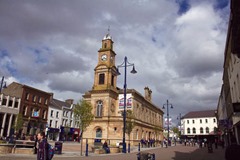A chequered history of Coleraine
 Ancient and modern Ulster can both trace their roots back to events in and around Coleraine. agendaNi explores the town’s rich history.
Ancient and modern Ulster can both trace their roots back to events in and around Coleraine. agendaNi explores the town’s rich history.
1613 marks the 400th anniversary of the charter for Coleraine, as well as Derry’s city status, but the town can also point to a much longer history as the oldest populated place on the island of Ireland.
In Tudor times, as local historian John Hamilton recalls, there was a “constant threat that Ireland would be used as a back door” by England’s European enemies. The military defeat of the Irish and Spanish armies at the Siege of Kinsale (1601-1602) and the Flight of the Earls (1607) gave England the upper hand.
In 1603, the whole of the British Isles came under the rule of King James I who “hated war because he didn’t like spending money”. Rather than a military occupation of Ulster, he encouraged the City of London’s guilds and livery companies to populate the area with English and Lowland Scots settlers. They would, of course, need to co-exist with the Irish population who already called it home.
Coleraine’s construction began in 1610. County Londonderry was initially known as County Coleraine before it took on its present name in 1613. Outside the town, smaller settlements grew up around the local parish church and fortified bawn.
Timber on the banks of the River Bann and its plentiful salmon stocks contributed to Coleraine’s economic success. Its location on an estuary opened up the town and county to traders from Britain and continental Europe. New forms of agriculture were also introduced.
“It was intended that the population of Scottish and English coming across here would replace the native population,” Hamilton adds. “However, in just about every instance, they failed to bring enough people.” Irish workers were recruited to man the farms and the two populations undoubtedly inter-married.
A curfew bell was tolled each night to order (mostly Irish) rural dwellers out of the town. Nearby, though, another Irish chieftain remained firmly in control thanks to his links to the Scottish-born king.
Randal MacDonnell switched allegiance to the crown when James succeeded to the throne. He was facing eviction by Sir Arthur Chichester, Lord Deputy of Ireland, whose brother John had been killed by Irish forces during the previous rebellion. MacDonnell shrewdly survived by arranging his own plantation, importing Presbyterian Scots from the Mull of Kintyre to what is now Bushmills and Ballycastle.
Coleraine was built with earthen ramparts which withstood a siege in 1642. However, many of the inhabitants perished from disease. As another army approached in 1689, the town was abandoned and the garrison and population sought refuge behind the walls of Derry.
While these events marked the start of the history of modern Ulster, they formed only the latest chapter in the island’s long story. Indeed, Coleraine is arguably the starting point for Irish history itself.
A mile south of the town centre lies Mountsandel Fort, where the earliest known settlement in Ireland was sited around 7000BC. Excavations in the 1970s found traces of hunter-gatherers from the Middle Stone Age. It seems likely that the early settlers were drawn to the site by the salmon.
The fort structure itself is thought to date from Norman times. Few other signs of history remain but a pleasant walk takes visitors down to the Bann.
As for the town’s name, it was reputedly given by St Patrick who named the site of his church Cuil Rathain: either the ferny corner or the rath at the meander. A pre-Plantation settlement existed in medieval times, again making use of the river and harbour, but the combined plans of a king, his planters and the local landowners established the area as we know it today.





